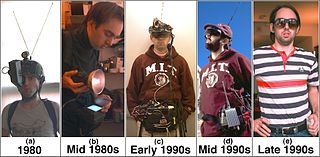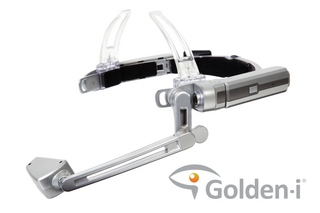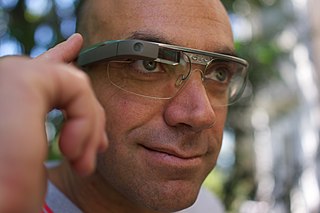
A wearable computer, also known as a body-borne computer, is a computing device worn on the body. The definition of 'wearable computer' may be narrow or broad, extending to smartphones or even ordinary wristwatches.

Augmented reality (AR) is an interactive experience that combines the real world and computer-generated content. The content can span multiple sensory modalities, including visual, auditory, haptic, somatosensory and olfactory. AR can be defined as a system that incorporates three basic features: a combination of real and virtual worlds, real-time interaction, and accurate 3D registration of virtual and real objects. The overlaid sensory information can be constructive, or destructive. This experience is seamlessly interwoven with the physical world such that it is perceived as an immersive aspect of the real environment. In this way, augmented reality alters one's ongoing perception of a real-world environment, whereas virtual reality completely replaces the user's real-world environment with a simulated one.

William Stephen George Mann is a Canadian engineer, professor, and inventor who works in augmented reality, computational photography, particularly wearable computing, and high-dynamic-range imaging. Mann is sometimes labeled the "Father of Wearable Computing" for early inventions and continuing contributions to the field. He cofounded InteraXon, makers of the Muse brain-sensing headband, and is also a founding member of the IEEE Council on Extended Intelligence (CXI). Mann is currently CTO and cofounder at Blueberry X Technologies and Chairman of MannLab. Mann was born in Canada, and currently lives in Toronto, Canada, with his wife and two children. In 2023, Mann unsuccessfully ran for mayor of Toronto.

Stereoscopy is a technique for creating or enhancing the illusion of depth in an image by means of stereopsis for binocular vision. The word stereoscopy derives from Greek στερεός (stereos) 'firm, solid', and σκοπέω (skopeō) 'to look, to see'. Any stereoscopic image is called a stereogram. Originally, stereogram referred to a pair of stereo images which could be viewed using a stereoscope.

Sousveillance is the recording of an activity by a member of the public, rather than a person or organisation in authority, typically by way of small wearable or portable personal technologies. The term, coined by Steve Mann, stems from the contrasting French words sur, meaning "above", and sous, meaning "below", i.e. "surveillance" denotes the "eye-in-the-sky" watching from above, whereas "sousveillance" denotes bringing the means of observation down to human level, either physically or hierarchically.

Computer-mediated reality refers to the ability to add to, subtract information from, or otherwise manipulate one's perception of reality through the use of a wearable computer or hand-held device such as a smartphone.
A keyer is an electronic device used for signaling by hand, by way of pressing one or more switches. The technical term keyer has two very similar meanings, which are nonetheless distinct: One for telegraphy and the other for accessory devices built for computer-human communication:

A head-mounted display (HMD) is a display device, worn on the head or as part of a helmet, that has a small display optic in front of one or each eye. An HMD has many uses including gaming, aviation, engineering, and medicine. Virtual reality headsets are HMDs combined with IMUs. There is also an optical head-mounted display (OHMD), which is a wearable display that can reflect projected images and allows a user to see through it.

A virtual retinal display (VRD), also known as a retinal scan display (RSD) or retinal projector (RP), is a display technology that draws a raster display directly onto the retina of the eye.
Equiveillance is a state of equilibrium, or a desire to attain a state of equilibrium, between surveillance and sousveillance. It is sometimes confused with transparency. The balance (equilibrium) provided by equiveillance allows individuals to construct their own cases from evidence they gather themselves, rather than merely having access to surveillance data that could possibly incriminate them.
High dynamic range (HDR), also known as wide dynamic range, extended dynamic range, or expanded dynamic range, is a dynamic range higher than usual.

Lifestreaming is an act of documenting and sharing aspects of one's daily experiences online, via a lifestream website that publishes things of a person's choosing.

A lifelog is a personal record of one's daily life in a varying amount of detail, for a variety of purposes. The record contains a comprehensive dataset of a human's activities. The data could be used to increase knowledge about how people live their lives. In recent years, some lifelog data has been automatically captured by wearable technology or mobile devices. People who keep lifelogs about themselves are known as lifeloggers.

A cyborg —a portmanteau of cybernetic and organism—is a being with both organic and biomechatronic body parts. The term was coined in 1960 by Manfred Clynes and Nathan S. Kline. In contrast to biorobots and androids, the term cyborg applies to a living organism that has restored function or enhanced abilities due to the integration of some artificial component or technology that relies on feedback.

SixthSense is a gesture-based wearable computer system developed at MIT Media Lab by Steve Mann in 1994 and 1997, and 1998, and further developed by Pranav Mistry, in 2009, both of whom developed both hardware and software for both headworn and neckworn versions of it. It comprises a headworn or neck-worn pendant that contains both a data projector and camera. Headworn versions were built at MIT Media Lab in 1997 that combined cameras and illumination systems for interactive photographic art, and also included gesture recognition.
In computing, a natural user interface (NUI) or natural interface is a user interface that is effectively invisible, and remains invisible as the user continuously learns increasingly complex interactions. The word "natural" is used because most computer interfaces use artificial control devices whose operation has to be learned. Examples include voice assistants, such as Alexa and Siri, touch and multitouch interactions on today's mobile phones and tablets, but also touch interfaces invisibly integrated into the textiles furnitures.

The Golden-i platform consists of multiple mobile wireless wearable headset computers operated by voice commands and head movements. It was developed at Kopin Corporation by a team led by Jeffrey Jacobsen, chief Golden-i architect and senior ddvisor to the CEO. Utilizing a speech controlled user interface and head-tracking functionality, Golden-i enables the user to carry out common computer functions whilst keeping their hands free.

Smartglasses or smart glasses are eye or head-worn wearable computers that offer useful capabilities to the user. Many smartglasses include displays that add information alongside or to what the wearer sees. Alternatively, smartglasses are sometimes defined as glasses that are able to change their optical properties, such as smart sunglasses that are programmed to change tint by electronic means. Alternatively, smartglasses are sometimes defined as glasses that include headphone functionality.
Cyborg data mining is the practice of collecting data produced by an implantable device that monitors bodily processes for commercial interests. As an android is a human-like robot, a cyborg, on the other hand, is an organism whose physiological functioning is aided by or dependent upon a mechanical/electronic device that relies on some sort of feedback.
Egocentric vision or first-person vision is a sub-field of computer vision that entails analyzing images and videos captured by a wearable camera, which is typically worn on the head or on the chest and naturally approximates the visual field of the camera wearer. Consequently, visual data capture the part of the scene on which the user focuses to carry out the task at hand and offer a valuable perspective to understand the user's activities and their context in a naturalistic setting.

















